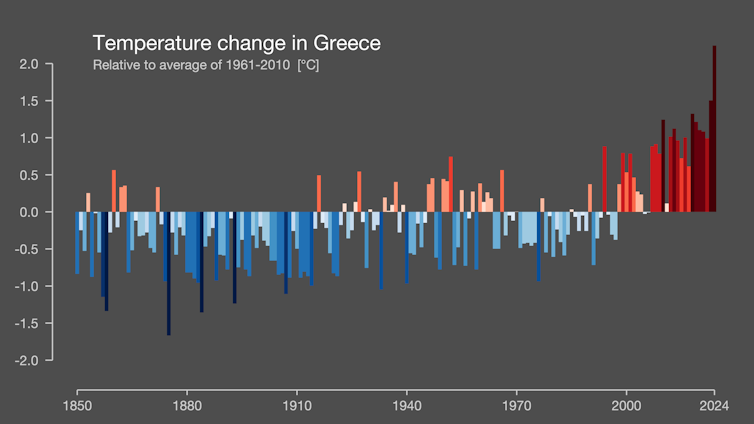Source: The Conversation – UK – By Ioanna Stamataki, Senior Lecturer in Hydraulics and Water Engineering, University of Greenwich
In recent years, I have all too often found myself passing over an active wildfire when flying from London to my family home in Greece during the summer months. The sky glows an eerie, apocalyptic red, and the scent of smoke fills the cabin. Silence falls as we become unwilling witnesses to a tragic spectacle.
Now wildfires are again raging across the Mediterranean. But the flames themselves are only part of the story. As wildfires become more intense and frequent, they’re setting off a dangerous chain reaction – one that also includes a rising risk of devastating floods.

Ioanna Stamataki
In January 2024, Nasa reported that climate change is intensifying wildfire conditions, noting that the frequency of the most extreme wildfires had more than doubled over the past two decades. While some of this is driven by natural weather variability, human-induced warming is clearly playing a major role. Decades of rising temperatures combined with longer and more severe droughts have created ideal conditions for wildfires to ignite and spread.
This year, another brutal Mediterranean wildfire season is unfolding right before our eyes, with numerous active wildfire fronts across the region. As of July 22 2025, 237,153 hectares have burned in the EU – an increase of nearly 78% from the same period last year. The number of fires rose by about 45%, and CO₂ emissions increased by 23% compared to 2024. These are terrifying statistics.
Climate phenomena are closely interconnected
The fires themselves are bad enough. But they’re also closely connected to other climate-related extremes, including floods.
Natural hazards often trigger chain reactions, turning one disaster into many. In the case of floods, wildfires play a big role both through weather patterns and how the land responds to rain.
On the weather side, higher temperatures lead to more extreme rainfall, as warmer air can hold more moisture and fuels stronger storms. Intense wildfires can sometimes get so hot they generate their own weather systems, like pyrocumulus clouds – towering storm clouds formed by heat, smoke and water vapour. These clouds can spark sudden, localised storms during or shortly after the fire.
The damage doesn’t end when the flames die down. Satellite data shows that burned land can remain up to 10°C hotter for nearly a year, due to lost vegetation and damaged soil.
As the world warms, the atmosphere is able to hold about 7% more moisture for every extra degree. Recent temperatures of 40°C or more in Greece suggest a capacity for more downpours and more flooding.

Ed Hawkins / Show Your Stripes (Data: Berkeley Earth & ERA5-Land), CC BY-SA
Wildfires also make the land itself more vulnerable to flooding. Burnt areas respond much faster to rain, as there is less vegetation to slow down the water. Wildfires also change the soil structure, often making it water-repellent. This means more water runs off the surface, erosion increases, and it takes less rain to trigger a flood.
Under these conditions, a storm expected once every ten years can cause the sort of catastrophic flooding expected only every 100 to 200 years. Water moves much faster across scorched landscapes without plants to slow it down. Wildfires also leave behind a lot of debris, which can be swept up by fast-moving floodwaters.
While EU-wide data on post-wildfire flood risk is still limited, various case studies from southern Europe offer strong evidence of the connection. In Spain’s Ebro River Basin, for example, research found that if emissions remain high and climate policy is limited, wildfires will increase the probability of high flood risk by 10%.
Nature’s ability to regenerate is nothing short of magical, but recovering from a wildfire takes time. Burnt soil takes years to return to normal and, during that time, the risks of extreme rainfall are higher. Beyond the impact of wildfires on soil and water, it is important not to overlook the devastating loss of plant and animal species or even entire ecosystems, making the natural world less biodiverse and resilient.
To reduce the frequency and severity of extreme events, we must focus on repairing climate damage. This means moving beyond isolated perspectives and adopting a multi-hazard approach that recognises how disasters are connected.
Flooding after wildfires is just one example of how one crisis can trigger another. We need to recognise these cascading risks and focus on long-term resilience over short-term fixes.
Get your news from actual experts, straight to your inbox. Sign up to our daily newsletter to receive all The Conversation UK’s latest coverage of news and research, from politics and business to the arts and sciences.
![]()
Ioanna Stamataki currently receives funding from the Leverhulme Trust and the Royal Society for ongoing flood research. Previous research has been supported by the EPSRC and the Newton Fund (via the British Council) for career development and international collaboration.
– ref. Flames to floods: how Europe’s devastating wildfires are fuelling its next climate crisis – https://theconversation.com/flames-to-floods-how-europes-devastating-wildfires-are-fuelling-its-next-climate-crisis-262204









